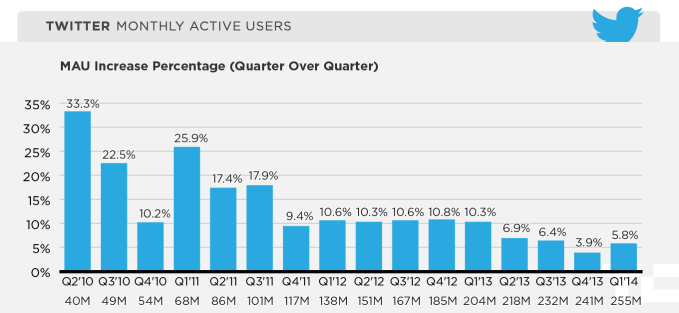Wall Street thinks Twitter has a growth problem, but CEO Dick Costolo said at CodeCon its reach includes people who see tweets on TV and embedded online though they aren’t counted in its 255 million users. Costolo also discussed trying to figure out how to get Twitter into China. But while reach is nice, the problem is that Twitter can only show ads to logged-in users.
That doesn’t mean these incidental users aren’t valuable. Seeing tweets visualized during news casts, hashtags splayed out on commercials and billboards, and threads hosted on blogs surely primes people to become Twitter users. But it has to convert them somehow.
Twitter’s growth rate has improved in the last quarter, but only after falling sharply for a year. In Q4 2012 its monthly active user count was up 10.8 percent quarter over quarter, and up 10.3 percent In Q1 2013. But growth sunk to 6.9 percent in Q2 2013. Twitter’s share price fell 18 percent when it reported growth had slumped to just 3.9 percent in Q4 2013, prompting concerns of a growth crisis. And $TWTR got dragged down 11 percent to its lowest value yet so far when its Q1 2014 growth rate improvement to 5.8 percent didn’t impress investors.

Contributing to the growth problem may be the struggle to reactivate burned users. Millions have signed up but churned out because Twitter failed to demonstrate the immense value of subscribing to condensed insights from friends and top thinkers. Many new users have trouble building an audience or finding the right people to follow, so they stop using Twitter.
In some ways that could be worse than them never signing up at all. At least they’d still be curious and Twitter would have a fresh chance to impress them. Instead, it has to convince them it’s much better than it was.
One way to make people feel more welcome is to get users more favorites, replies, and retweets per tweet. Costolo said on stage that Twitter’s been very focused over the course of the last six to nine months on increasing per-tweet engagement. It’s seen an increase in retweets and comments. Growth is based on increased engagement per timeline view, but that’s one side of the engagement coin, he noted.

Perhaps getting into China could help. Costolo said he didn’t expect Twitter or Facebook to be unblocked by the Great Firewall Of China in the forseeable future, but was still in early conversations about what a government-OK’d Twitter would look like. For now, Twitter is happy to take advertising dollars from Chinese businesses that want to reach an international audience.
To get Twitter growing soon, it may need to concentrate harder on its onboarding flow. It’s already better than old versions that just subscribed users to some celebrities and dumped them into the service. Now Twitter walks rookies through how to tweet, and finds them people to follow that align with their interests.
But the answer to boosting retention amongst new users may be finding them an audience. Twitter may need to push hard to get veterans to follow and engage with new sign-ups who they know. Facebook managed this by sucking in people’s address books so it could recommend they friend their contacts who signed up later. Twitter might need to push harder on this dimension, because nothing feels quite as lame as tweeting to nearly zero followers. No one likes shouting into a black hole.
[Image Credit: Re/Code]